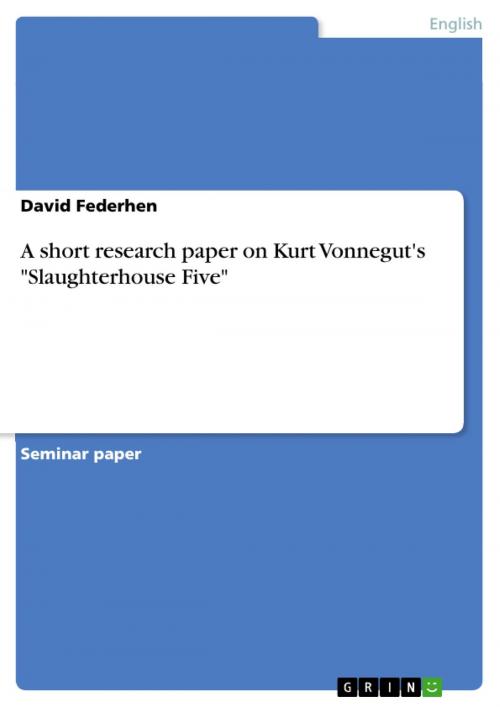A short research paper on Kurt Vonnegut's 'Slaughterhouse Five'
Nonfiction, Entertainment, Drama, Anthologies| Author: | David Federhen | ISBN: | 9783638187596 |
| Publisher: | GRIN Verlag | Publication: | April 26, 2003 |
| Imprint: | GRIN Verlag | Language: | English |
| Author: | David Federhen |
| ISBN: | 9783638187596 |
| Publisher: | GRIN Verlag |
| Publication: | April 26, 2003 |
| Imprint: | GRIN Verlag |
| Language: | English |
Seminar paper from the year 2002 in the subject American Studies - Literature, grade: A (deutsch:1), International University in Germany Bruchsal (Department of Sciences and Liberal Arts), 9 entries in the bibliography, language: English, abstract: Introduction Kurt Vonnegut, Jr. is considered one of the greatest American authors ever. He wrote about 30 novels, an uncounted number of short-stories and a few essays and plays. His most successful novel, Slaughterhouse-Five or The Childrens' Crusade, a Duty Dance with Death, was his sixth book and published in 1969. This research paper will focus on the connection between Billy Pilgrim, the main character of Slaughterhouse-Five, and the life of Kurt Vonnegut. Furthermore, it will make use of this connection in order to suggest why Kurt Vonnegut wrote this book. Pilgrim, who is an American World War II veteran and survived the allied air raid on Dresden in early 1945, strikes the reader as a very eccentric person. He believes that he 'has come unstuck in time' (Vonnegut, 1991, p.23) and time travels to his childhood, to his wedding, to the Battle of the Bulge and to the air raid. But not only that he has lost control over the temporal aspects of his life, he furthermore believes that he has been kidnapped by aliens from the planet Tralfamadore and taken to their world as an exhibit in a terrarium. In order to point out the close relationship between the author and the main character I will subdivide this paper into several sections, shortly giving information about the author's biography and providing a quick summary of Slaughterhouse-Five. This information has to be considered and related in order to understand Vonnegut's motivation for writing this novel. It is vital to realize that Pilgrim is Vonnegut and that whatever Pilgrim feels is what Vonnegut experienced in his life.
Seminar paper from the year 2002 in the subject American Studies - Literature, grade: A (deutsch:1), International University in Germany Bruchsal (Department of Sciences and Liberal Arts), 9 entries in the bibliography, language: English, abstract: Introduction Kurt Vonnegut, Jr. is considered one of the greatest American authors ever. He wrote about 30 novels, an uncounted number of short-stories and a few essays and plays. His most successful novel, Slaughterhouse-Five or The Childrens' Crusade, a Duty Dance with Death, was his sixth book and published in 1969. This research paper will focus on the connection between Billy Pilgrim, the main character of Slaughterhouse-Five, and the life of Kurt Vonnegut. Furthermore, it will make use of this connection in order to suggest why Kurt Vonnegut wrote this book. Pilgrim, who is an American World War II veteran and survived the allied air raid on Dresden in early 1945, strikes the reader as a very eccentric person. He believes that he 'has come unstuck in time' (Vonnegut, 1991, p.23) and time travels to his childhood, to his wedding, to the Battle of the Bulge and to the air raid. But not only that he has lost control over the temporal aspects of his life, he furthermore believes that he has been kidnapped by aliens from the planet Tralfamadore and taken to their world as an exhibit in a terrarium. In order to point out the close relationship between the author and the main character I will subdivide this paper into several sections, shortly giving information about the author's biography and providing a quick summary of Slaughterhouse-Five. This information has to be considered and related in order to understand Vonnegut's motivation for writing this novel. It is vital to realize that Pilgrim is Vonnegut and that whatever Pilgrim feels is what Vonnegut experienced in his life.















